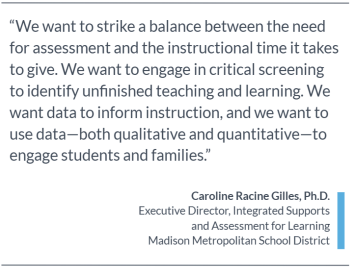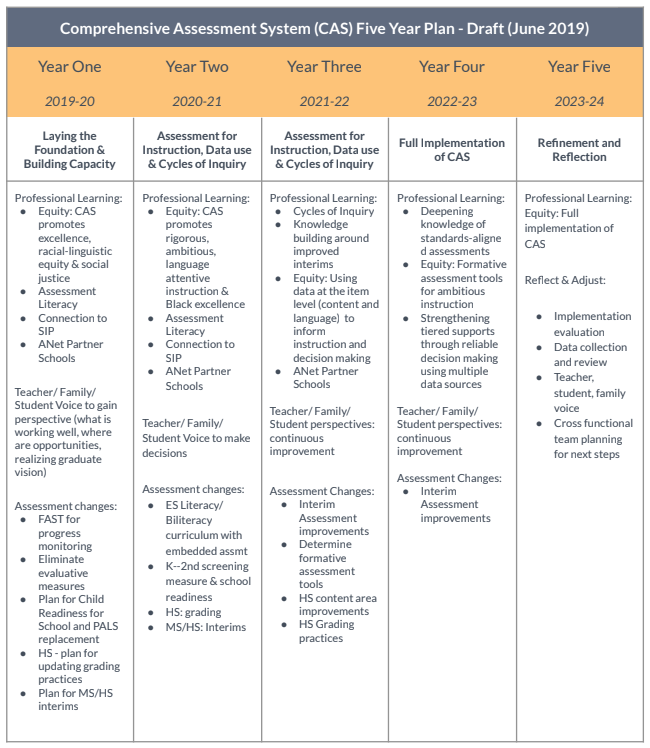The District:
The Madison Metropolitan School District (MMSD) in Madison, Wisconsin serves over 27,000 students in 52 schools, with 44 of those schools serving grades 2-8. In MMSD, 50% of students come from economically disadvantaged households and 57% are students of color.
Historically, Black students have struggled to thrive at MMSD. Several years ago, the district engaged the community on how to focus attention on dramatically improving the school experience of the district’s Black youth. With over 2,500 parents, students, educators and community members informing the district’s new strategic framework, launched in 2018-19, MMSD created a specific goal around Black Excellence – that African American children and youth excel in school. It is a key component in the district’s path forward.
Challenge:
MMSD needed an assessment strategy.
Teachers were administering assessments that did not provide actionable data for their planning. Students—of course—were not benefiting from this approach to assessments, either. In particular, MMSD recognized Black students were not receiving equitable support, evidenced in part by historically lower proficiency in both math and ELA.
As the district worked to develop a new assessment strategy, several related challenges surfaced along the way. MMSD leaders realized departments within the district were fragmented and unclear channels of communication were hindering progress. They had never seen one another’s work and were not clear about what they were all supposed to accomplish together to see change in schools. Before they would see results from a new assessment strategy, the district needed to increase collaboration across management, curriculum, and assessment functions.
In 2018-19, MMSD launched a partnership with ANet focused on creating the district conditions for increased system coherence that would advance the creation and implementation of a comprehensive assessment strategy.
Results:
-
MMSD now has new and stronger operative structures and communication practices.
-
They have successfully developed and are implementing their comprehensive assessment strategy, allowing teachers to spend less time assessing for accountability and more time understanding student learning and making “just in time” adjustments to their teaching practices.
-
School leaders are feeling extraordinary clarity on district priorities, are supportive of the district vision, and are confident in the use of data.

-
Early results indicate that Black students are beginning to close the scores gap. Several elementary schools are piloting a new curriculum to ensure stronger alignment to the shifts the entire district has taken in their assessment strategy. In these schools, all students are performing higher overall, and Black students are performing higher than their Black peers at non-piloting schools. In fact, all demographic groups in the pilot schools outperformed similar groups in non-piloting schools.
The Approach:
In the first two years of their partnership with ANet, MMSD leaders defined their strategy, aligned their structures, and changed their operating behaviors. Now, they are implementing their comprehensive assessment strategy and beginning to see results.

Understand the assessment system
With ANet’s support, the district convened an Assessment Priority Project working group. Caroline Racine Gilles is MMSD’s executive director of Integrated Supports and Assessment for Learning. She explains how the working group began by gathering a comprehensive inventory of existing system-wide assessments in and across grade bands. The group then evaluated each of these assessments against research-based criteria.
After developing a clear picture of the quality and purpose of each assessment, the working group generated recommendations for which assessments to keep, cut, or modify in order to improve the quality, consistency, and implementation of assessments across MMSD.

As part of this process, the working group built an understanding of the ways to classify assessments (for example, by cycle length and purpose) in order to develop their common language and shared definitions. They used their common understanding to align on which assessments should serve instructional, predictive, or evaluative purposes across the district. “We recognized that we had a glut of evaluative assessments, which indicated the need to incorporate assessments closer to instruction,” Racine Gilles shares. Therefore, they refocused on the inclusion of instructional assessments and the structures that would enable teachers to use data from these assessments to uncover students’ needs and inform instruction. “In particular,” Racine Gilles explains, “we want to strike a balance between the need for assessment and the instructional time it takes to give. We want to engage in critical screening to identify unfinished teaching and learning. We want data to inform instruction, and we want to use data—both qualitative and quantitative—to engage students and families.”

Along the way, the working group solicited teacher and family input on their assessment experience. They also discussed the connections between data reports and assessment purpose, specifically asking, do the reports enable each assessment to be used for its intended purpose?
All of this led the working group to build their own knowledge and expertise in order to make recommendations to improve quality and streamline the overall assessment strategy within the district. “We concluded our work with crafting our current assessment vision,” says Racine Gilles, “which is grounded in the notion that assessment is an equity strategy.”
Create a vision
Equipped with their assessment vision and recommendations from the working group, MMSD leaders then collaborated to create a multi-year plan to implement their Comprehensive Assessment System. They knew this work would not happen overnight, and they wanted to be clear about the pace and sequence of internalization, implementation, and refinement.

Kaylee Jackson, MMSD’s executive director of curriculum and instruction, talks about their use of assessments as a key equity strategy. “First and foremost,” she says, “we know that equity means ensuring that all students have access to high quality, high rigor, grade-level appropriate materials and instruction. And one way to ensure that is to see how students are performing at grade level.” She explains that, previously, the district was completely focused on using adaptive assessments, but this approach did not give them a deep understanding of how students were performing relative to grade-level expectations.
![Graphic with a quote that says: MMSD kicked off professional learning for the 20-21 school year by grounding teachers and leaders in the beliefs and strategies behind the assessment shifts. "Data should never be used as a gatekeeper to grade level content. That is a racist approach to using data. Instead, data is used for us [teachers and school leaders] to inform our instructional moves. It also means that we should not be testing our most marginalized students all of the times, but that we are using the best data and the shortest assessments and assessment cycles to respond and respond well." The quote is by Kaylee Jackson.](https://images.squarespace-cdn.com/content/v1/5321dc4ae4b0c72ad0ceedfe/2b3309e5-7b61-4f06-bfe4-753e8fbc5c71/Screenshot+2023-04-24+at+2.53.08+PM.png)
Last year was about building the foundation and capacity across the district: ramping up professional learning that focuses on equity and assessment literacy; gathering teacher, family, and student perspectives on what’s working well and the opportunities in the district; and making the initial assessment changes. Now they are in year two, Jackson notes, and “this year really included ensuring we had more assessments closer to instruction. They are assessments for learning and not assessments of learning.”
Communicate as one band, one sound
While developing the foundation for their Comprehensive Assessment System, MMSD leaders saw a disconnect across departments. Department leaders were operating in silos; they had not seen much of each other’s work and were not positioned to provide cohesive support for their new assessment strategy. They saw the need to restructure. “Recognizing we didn't have an organizational structure that promoted a streamlined approach to assessment, it became important for us to work across departments and name our challenges,” Caroline Racine Gilles reflects. “We focused on problem-solving across systems-level barriers such as disengagement or role clarity, fragmentation, and unclear focus and management.” She adds that, when a district is not coordinated, teachers and students are impacted most: “We continue to work on these system-level challenges because we know if they are not addressed, they impact teacher instruction, and ultimately, student learning.” MMSD’s increased collaboration across management, curriculum, and assessment functions is all in service of teaching and learning.

They also revised their Theory of Action to articulate how system-level teams provide the tools and support to amplify the teaching, learning, and assessment practices happening in schools and classrooms. Kaylee Jackson describes how student data—and a specific plan for how it is used—is incorporated into planning at every level from classrooms to the central office. “If we say that teachers need to use student data, and if we're saying it's a good practice for them, it also needs to be a good practice for us,” she says. All directors on her team, she notes, have plans rooted in data, and they return to it regularly.
MMSD’s intentionally designed professional learning plans have equipped teachers and leaders with the tools they need. Jackson shares that her Curriculum and Instruction team works closely with instructional coaches to design their professional learning. To ensure they were able to truly understand the different types of assessments and how data should be utilized, Jackson notes that PL for the district’s instructional coaches focused specifically on assessments and data at the beginning of this year.
Teachers and school leaders receive intentionally designed training with the same messaging, as well. “We tried to have really specific learnings and professional development so that teachers and principals and instructional coaches all knew the difference between those different assessments and the different purposes of them, Jackson reflects, adding, “And how to use them for planning.”
Strong and steady implementation
In these early years of their Comprehensive Assessment System, MMSD’s focus has been on first laying the foundation and, next, understanding assessments for instruction, data use, and cycles of inquiry.
![Graphic with a quote by Jackie Smith that says, "With ANet, we talked about how high level, standards-aligned quality assessment gives students opportunities to engage in grade level learning. And then [we focused on] how the intersection of reading and writing really build together as we talked about what the shifts of the Common Core standards mean. I think engaging in that assessment was kind of a big 'aha' - a calibration for us around what Common Core standards-aligned instruction looks like, and it also gave us the [realization] that we were miscalibrated a little bit, so we needed to do some work."](https://images.squarespace-cdn.com/content/v1/5321dc4ae4b0c72ad0ceedfe/eefc6dd8-8097-4a1e-ac59-2f408f932070/Screenshot+2023-04-24+at+2.53.24+PM.png)
Jackie Smith is in her fifth year as the principal at Gompers Elementary. She first attended a session led by ANet two years ago, and she quickly understood how a partnership with ANet would support the shifts the district is making and the work happening at her school. She describes her “aha moment” in this session when analyzing a standards-aligned assessment and understanding its connection to grade-level learning. “Engaging in that assessment,” she shares, “was kind of a big ‘aha’ —a calibration for us around what common core standards-aligned instruction looks like. It also gave us the notion that we were miscalibrated a little bit, so we needed to do some work.”
As Smith and her team’s understanding of high-quality assessments evolved, they also recognized a need to make deeper shifts in their instructional practices: “By wanting to support students who were struggling the most through small-level texts, we were actually holding them back. We began to do more learning and digging… which drove us to the need to have more complex texts and have kids reading and writing and speaking about it.” She recognized the changes they needed to make would not be simple, however, understanding “we can’t be curriculum writers and teachers and reflect and adjust all at once.” So, at Gompers Elementary, they decided a new, more rigorous and better-aligned ELA curriculum would best support teachers.
Smith explains how the coaching partnership she built with ANet after that first session has continued to support the work happening at her school each step of the way, “ensuring we’re providing high-quality instruction, including what that looks like, making sure it is rigorous and standards-aligned, and making sure we weave that into our equity strategy.” Support from ANet has helped ensure that the instructional practices and anti-racist practices are one and the same when previously they felt disconnected. “High-quality instruction and giving kids really rigorous opportunities has been talked about in one realm and then racial equity and anti-racist practices are talked about in another realm. I think that our work with ANet has really supported us to continue to meld and to understand how instructional practices really are anti-racist practices,” she reflects.

As a result of their shifts, Smith shares they are seeing changes in both classroom instruction and student outcomes. When it comes to instruction, she says, “we are starting to take more ownership,” and that in the past they may have looked at a complex text and simply thought about how hard it was. Now, they plan to support students to be successful with the text or task and she sees “a direct link between instructional moves and students outcomes.”
“With student work,” Smith shares, “we are seeing a shift in their ability to engage with complex texts. We are seeing that kids are able to create text-dependent responses.”
Much of this, too, has happened amidst a pandemic and navigating remote instruction. The shifts they made across schools and at a system level were exactly what the district needed, Kaylee Jackson reflects. “We saw that our assessment strategy was actually in great alignment to what we needed during this pandemic, which is more frequent use of data for learning to influence our instructional moves. We needed to spend our time smarter.”
Image Appendix
Below is a copy of Madison Metropolitan School District’s Comprehensive Assessment System (CAS) Five Year Plan. Please note this draft is a version updated in June 2019.

Below is Madison Metropolitan School District’s Theory of Action.

This material is licensed for use under the CC-BY-NC-ND license
© 2023 The Achievement Network, Ltd.
To learn more about ANet, visit us at achievementnetwork.org
Want to learn more about the improved student outcomes that resulted from ANet’s Breakthrough Results Study?
Check out our findings from the multi-year study at ANetGetsResults.org.
